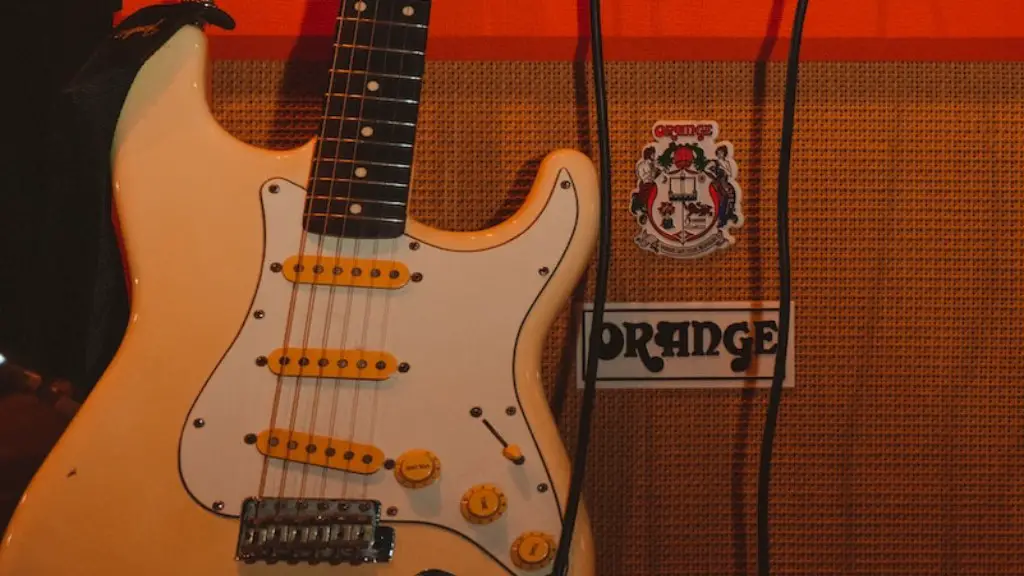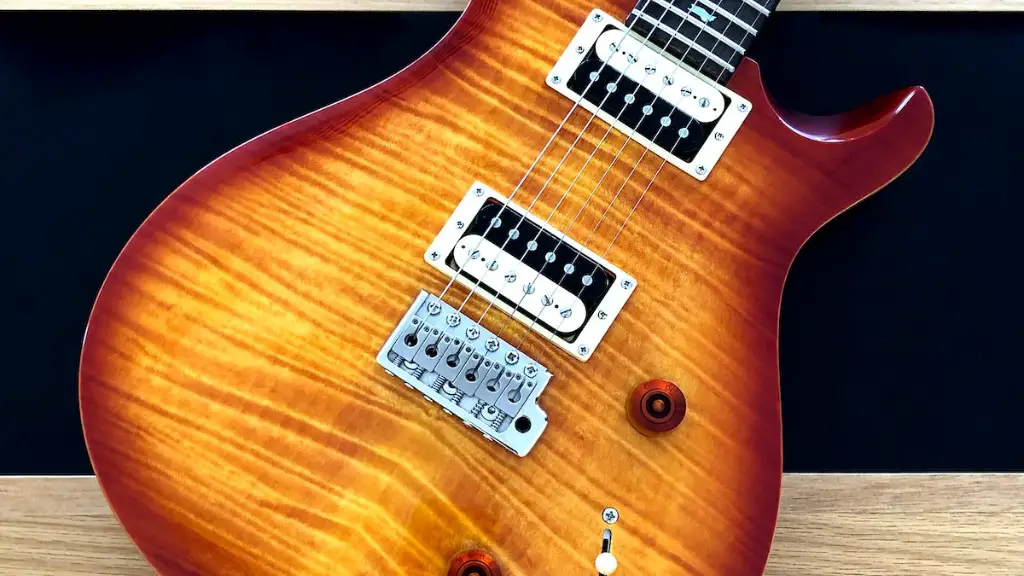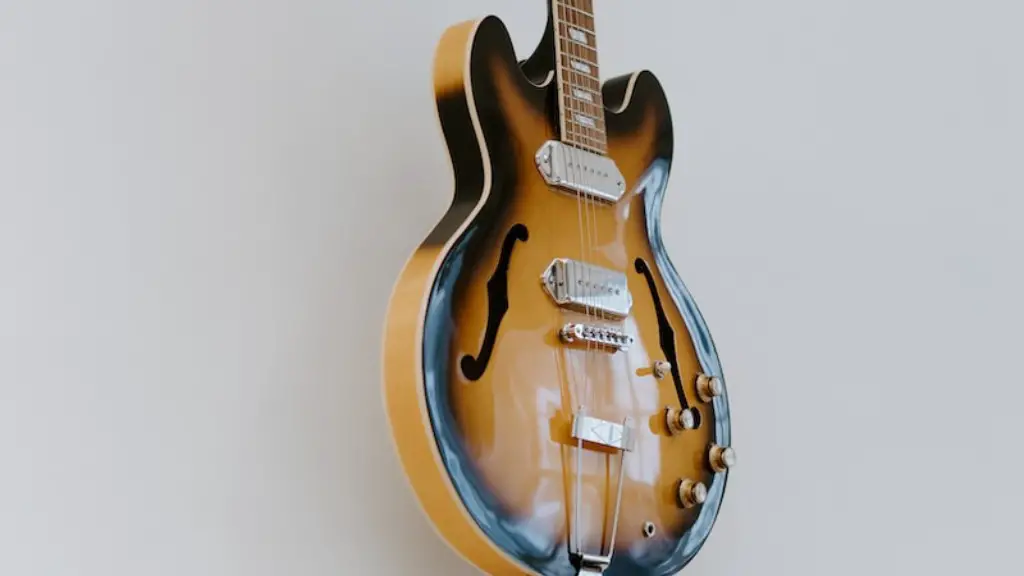The electric guitar is a versatile musical instrument that has had a huge impact on popular music. It is one of the most recognizable instruments in the world and has been used in almost every genre of music. But what sound does an electric guitar make?
An electric guitar produces a rich, full-bodied sound that is often described as “warm.” This sound is created by the combination of the strings, pick-ups, and amplifier. The strings vibrate when plucked, creating sound waves that are picked up by the pickups and sent to the amplifier. The amplifier then amplifies these signals to create a louder sound.
The type of sound an electric guitar produces can vary greatly depending on its construction, pickups, and amplifier settings. For example, single-coil pickups produce a brighter, more trebly tone than humbucker pickups which are known for their fuller, warmer tone. Different amp settings can also drastically change an electric guitar’s sound. This allows players to customize their tone to suit different genres or playing styles.
Creating Unique Sounds with an Electric Guitar
Electric guitars have the capability to generate a wide array of sounds, from classic rock riffs to subtle jazz tones. The two main components of an electric guitar are the pickups and the amplifier, which work together to create sound. Pickups are magnets that capture the vibrations of the strings and carry them as electrical signals to the amplifier. The amplifier then enhances these signals and projects them through a speaker.
By adjusting certain settings on the amp, such as gain, treble, and bass, you can create an array of different sounds that range from light and airy to heavy and distorted. Experimenting with different settings will help you find your own unique sound. You can also use effects pedals to further shape your tone. Pedals provide additional processing such as delay or reverb that can add depth to your sound.
Ultimately, creating unique sounds on an electric guitar comes down to experimentation. Learn how each component works and adjust it until you get the desired sound. Don’t be afraid to try something new—you never know what kind of creative sonic landscape you may discover!
The Different Types of Electric Guitars and Their Sounds
Electric guitars are the backbone of popular music. With a variety of different body shapes and pickups, electric guitars produce a wide range of sounds. Solid body electric guitars, such as the Stratocaster and Telecaster, are known for their bright twangy sound that is great for rockabilly and country. Semi-hollow electric guitars, like the Gibson ES335, have a mellower tone that lends itself to blues and jazz styles.
The pickups used in electric guitars are what give them their signature sound. Single-coil pickups tend to be brighter with more “twang” while humbucker pickups have a warmer tone with more output. Active pickups offer even more control over the guitar’s sound by allowing you to adjust the EQ settings for each pickup individually.
No matter what style of electric guitar you choose, they all share one thing in common: they provide endless creative possibilities. With the right combination of guitar and amp, you can create any sound you can imagine!
Using Effects Pedals to Enhance the Sound of Your Electric Guitar
Electric guitars produce a wide range of sound, from bright and jangly clean tones to distorted, saturated and overdriven sounds. Effects pedals can help you achieve the sound you want without having to make permanent modifications to your instrument. Effects pedals are devices that allow you to modify the sound of your guitar by altering the signal coming from your guitar. Some of the most commonly used effects pedals are distortion, reverb, delay, chorus, phaser and wah-wah.
Distortion pedals add a crunchy texture and sustain to your tone. Reverb adds depth and space, while delay can be used for creating echoes or ambient soundscapes. Chorus gives your guitar a shimmering quality, while phasers create a swooshing effect. Finally, wah-wah can be used for creating expressive vocal-like tones.
By combining different effects pedals in series or parallel with each other and with your amplifier’s tone controls you can create unique sounds that will make your guitar truly stand out. With careful use of effects pedals you can really bring out the best in your guitar’s tone and give it an unmistakable voice. So don’t be afraid to experiment – explore different combinations and see what sonic possibilities await!
The Role of the Amplifier in Electric Guitar Sounds
Electric guitars are iconic instruments that are used in many different genres of music. The sound they produce is unique and recognizable, and much of this sound is due to the amplifier used to amplify their signal. An amplifier boosts the guitar’s signal, allowing the player to control volume, tone, and other aspects of their sound. It also helps shape the overall sound of the guitar, adding clarity and depth to notes. Furthermore, an amplifier can be used to create a range of sonic textures that can help create a signature sound for any musician.
The type of amplifier used will also affect the overall sound that is produced. Tube amps tend to offer a warmer, richer tone compared to solid-state amps which generally provide a brighter, more cutting tone. Additionally, certain effects pedals can be added to an amp’s signal chain in order to create specific sounds. For example, a chorus pedal can provide a shimmering layer of texture over the notes being played while a distortion pedal adds overdriven harmonics for increased sustain and edge.
Ultimately, the electric guitar’s iconic sound cannot be achieved without an amplifier – its role is integral in creating this unique tone that many musicians strive for. With careful consideration and experimentation with different types of amplifiers and effects pedals, any guitarist can find their own signature sound. No matter what type of music you play, having an appropriate amplifier will make all the difference.
How to Choose Pickups for Your Electric Guitar
Choosing the right pickups for your electric guitar is essential for getting the sound you want. Pickups are the electromagnets that capture vibration from your strings and convert it into electrical signals that can be amplified. There are different types of pickups, each with their own unique sonic characteristics and tone. Humbuckers, single-coils, and P90s are some of the most popular electric guitar pickups. Humbuckers provide a thick, warm tone while single-coils are brighter and more articulate. P90s offer a nice balance between humbuckers and single-coils.
When selecting pickups for your electric guitar, consider the type of music you play as well as the sound you want to achieve. If you’re playing rock or metal music, humbuckers will generally give you a heavier sound than single-coils or P90s. For blues or jazz, single-coils may be a better choice since they have more brightness and clarity in their tone. P90s offer a good balance between these two options if you’re looking for something in between.
Take some time to experiment with different pickups on your electric guitar to find the perfect combination of sound and style for your playing style. With so many options available, it’s important to try out as many as possible before making a final decision. You may even find that mixing different types of pickups can give you just the right blend of tones for
Tips for Improving the Tone of Your Electric Guitar
The sound of an electric guitar is defined by a combination of its pickups, the kind of strings used, and the amplifier that it’s plugged into. To improve your guitar’s tone, start by changing your strings to a higher-quality set, then experiment with different pickups and amps. Try adjusting the volume and tone knobs on your guitar, as well as the gain on your amp. You can also use effects pedals to further shape your guitar sound and create unique tones. Finally, practice regularly to develop a better understanding of your instrument and its potential.
To get you started with improving the tone of your electric guitar, here are a few tips:
- Choose strings made from nickel or steel for bright tones
- Pickups with higher output levels will give you more power
- Experiment with different amplifiers to find the right sound
- Adjusting the volume, tone and gain knobs will give you various tonal options
- Using effects pedals can provide more creative options
- Practice regularly to develop an understanding of your instrument
By making these small changes to your setup you can drastically improve the tone of your electric guitar. Have fun experimenting with different sounds
The Bottom Line
An electric guitar produces a wide variety of sounds and tones, from the classic bluesy twang to crunchy metal distortion. It is an incredibly versatile instrument that allows players to create any sound they desire. The sound of an electric guitar varies depending on how it is played, the type of pickups and strings used, as well as the effects added. All in all, an electric guitar can make a powerful statement with its unique range of tones and sounds. No matter what style you play, there’s an electric guitar that can help you make your music come alive.
Electric guitars are a great way for aspiring musicians to express themselves through music and are often used in many genres ranging from rock to jazz. With its ability to produce a wide array of sounds, the electric guitar is one of the most popular instruments used by professional musicians today. Whether you’re just getting started or already have some experience playing the electric guitar, there’s something for everyone when it comes to creating unique musical sounds with this versatile instrument.




